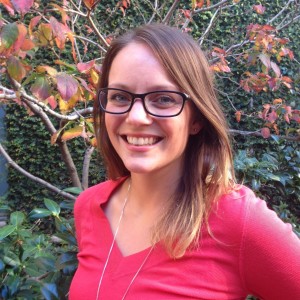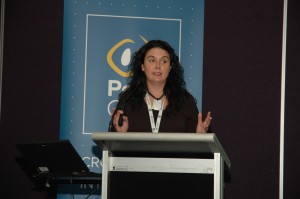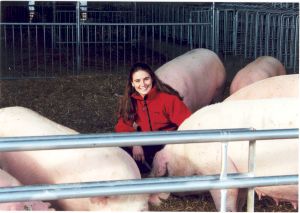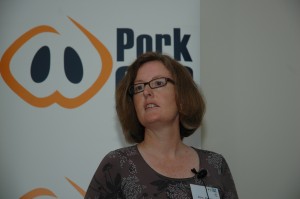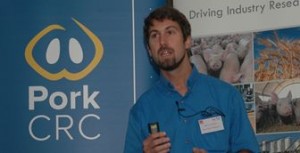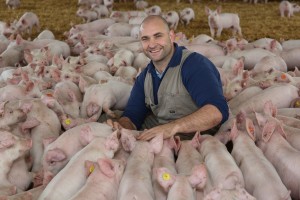Dr Rebecca Doyle
Progressing positive pig welfare
Pork CRC Project 1A-111: ‘Developing ways to measure and increase sow contentment’
Animal welfare has traditionally focused on negative issues, aiming to eliminate or minimise situations of distress, pain, fear and poor health. This is a crucial step to improving an animal’s quality of life, but it doesn’t necessarily mean that an animal is in a ‘good’ welfare state. To assess an animal’s welfare more completely we need to be able to measure whether or not positive experiences and positive welfare changes are occurring and to what degree.
In animal welfare science we have a whole box of tools to assess negative welfare, including the assessment of a pig’s physiology, behaviour and physical condition. The tools we have available to assess positive welfare are limited however.
Measuring welfare
A recently commissioned study by the Pork CRC aims to identify indicators of positive welfare in sows that can be used in a large scale production setting. Dr Rebecca Doyle from the Animal Welfare Science Centre at The University of Melbourne, leads Pork CRC Project 1A-111, ‘Developing ways to measure and increase sow contentment’. The research team comprises Dr Kate Plush and Dr Cameron Ralph, South Australian Research and Development Institute, Dr Rebecca Morrison, Rivalea Australia, Dr Susan Hazel, The University of Adelaide, Dr Greg Cronin, The University of Sydney and Dr Caroline Lee, CSIRO. Together the team covers a breadth of expertise in sow welfare assessment, physiology, behaviour and production.
Project leader
Dr Rebecca Doyle moved to the Animal Welfare Science Centre in May 2014, after four years lecturing in animal physiology and welfare at Charles Sturt University, Wagga Wagga, NSW. Her research experience focuses on the development of novel ways to assess animal welfare and ranges from the development of fundamental research techniques to practical methods. Dr Doyle’s research experience in pigs includes investigating the recovery of piglets in hospital pens and she supervises APL PhD student, Rebecca Wilson, whose project ‘Assessment and alleviation of aversive stimuli in pigs’ is measuring the efficacy of anti-inflammatory treatments on the recovery of ill weaner pigs, and uses traditional and novel techniques to gauge recovery. Dr Doyle has also developed novel measures of welfare in other species that will be trialled in the planned project.
Positive processing
The first phase of the Pork CRC study involves a controlled trial where the most recent welfare assessment techniques will be trialled on sows receiving either enrichment or not. It will look at the cognitive processing of sows during lactation and measure differences in the enrichment versus control group. It has been repeatedly demonstrated that animals in a more positive welfare state process information more positively and respond behaviourally in a more ‘optimistic’ way – essentially they have an increased expectation of a reward despite ambiguous information. Animals in a more negative welfare state process information more negatively and respond behaviourally in a more ‘pessimistic’ way, having an increased expectation of punishment.
This experimental technique will be compared to other more practical indicators that can be used on farm. The second part of this study will investigate the practicality of these measures of contentment in a commercial setting.
Novel measures
This study’s controlled and then practical approach will ensure the methods developed to assess sow contentment are accurate and practical. According to Dr Doyle, the project has the potential to develop novel measures of positive sow welfare.
“With the correct tools we can assess what situations are likely to lead to positive welfare outcomes and what sort of health, behavioural and production benefits this may have for a pig. This is also beneficial because we may be able to identify those animals whose welfare is likely to be compromised and intervene before a state of distress is reached,” she explained.
Innovative CRC
The study is the first of its kind to assess positive welfare in a practical setting and highlights Pork CRC’s innovative approach. This project aims to deliver science-based information on ways to assess contentment and welfare that will benefit producers. This type of research contributes to a level of confidence for consumers that the pork industry is proactively investigating and improving pig welfare and will provide information that will allow the Australian pig industry to stay ahead of upcoming issues concerning the assessment and improvement of pig welfare.
Further information: Dr Rebecca Doyle, email Rebecca.Doyle@unimelb.edu.au
Rebecca Morrison
Welfare Priority One for Program One Project Leader
Rebecca Morrison attended the University of Melbourne and completed her PhD in 1992 under the supervision of Professor Paul Hemsworth, Dr Greg Cronin and Dr Roger Campbell.
The PhD investigated the social and feeding behaviour of growing pigs in deep-litter, group housing systems. Twenty three years later, Rebecca remains committed to animal welfare and housing research and implementing welfare programs within Australia’s pork industry.
After completing her PhD, Rebecca moved to the USA to a newly created role as Sustainable Swine Production Systems Scientist the University of Minnesota, West Central Research and Outreach Centre (WCROC). The position involved 70% research and 30% outreach and extension, working closely with pork producers who were using more ‘alternative’, sustainable systems such as free-range and straw-based group housing for gestating and farrowing sows and their progeny. Many of these smaller producers were producing pork for niche markets in the USA. WCROC was one of the first USA research centres to research and develop loose, deep-litter housing for gestating and farrowing sows and their progeny and it still leads the way in this area.
Rivalea return
In 2003, Rebecca and her family moved back to Australia, where she commenced as a Research Scientist for Rivalea (then Bunge), specialising in pig welfare and housing. She continued her association with University of Melbourne/Animal Welfare Science Centre and still works closely with this group. Rivalea has supported and facilitated a large number of Pork CRC and APL sow housing projects during the past 12 years, including Determining group size and floor space requirements for group housed sows (CRC 1C-105), Welfare and performance of group-weaned sows (CRC 1C-111), Effects of aggressive characteristics of individual sows and mixing strategies on the productivity and welfare of group-housed gestating sows (CRC 1C-102), Strategies to enhance the performance of pigs at weaning (CRC 2B-103 and 2B-107) and Validation of on-farm welfare indices (APL 2013-062). Results from these experiments have helped guide Australian pork producers as they moved to eliminate gestation stalls.
Welfare management
More recently, Rebecca accepted the position as Animal Welfare Programs Manager for Rivalea, a role in which she leads the animal welfare research program and is responsible for implementing animal welfare programs at Rivalea. She works with Rivalea Veterinarians, Farming Operations, Meat Processing, Quality Assurance and Learning and Development teams to implement animal welfare programs and to strive for continuous improvement in animal welfare. Rebecca also works closely with animal welfare groups and customers to develop animal welfare standards.
Rivalea committed to investing in research and development of loose farrowing systems in 2007 when it was identified that there was significant development in loose farrowing systems in Europe and by Dr Greg Cronin at University of Sydney and it did not make sense to ‘re-invent the wheel’. Rivalea instigated collaboration with internationally-recognised groups working in the area and Rebecca continues to work with Dr Emma Baxter (Scotland’s Rural College, UK), Prof Sandra Edwards (Newcastle University, UK), Dr Vivi Mouststen (Danish Agriculture and Food Council, Denmark) and Janni Hales (University of Copenhagen, Denmark), plus Dr Cronin.
CRC projects
The Pork CRC has supported two large projects in Program 1– Reduced confinement of sows and piglets – that aim to develop commercially viable loose farrowing systems for the Australian environment. 1A-105: Developing commercially-viable, confinement-free farrowing and lactation systems (in collaboration with Dr Greg Cronin, University of Sydney) and 1A-109: Innovative refinements of existing lactation pen systems to better suit Australian environmental and management systems. These projects aim to develop loose farrowing systems for the Australian environment. Recently, the specific loose farrowing pen design criteria to meet the biological needs of the farrowing sow and piglets and the needs of the pork producer have led to the development of loose farrowing systems (e.g. Norwegian UMB and the PigSAFE farrowing pens – see final reports ).
System changing
In order to satisfy piglet and sow biological needs it is unlikely any loose farrowing system will operate effectively in the footprint of an existing farrowing crate space. An additional system would be needed to maximise throughput of sows through these ‘high cost’ systems. The current Pork CRC project is also investigating a ‘two-stage system’, allowing farrowing in a specialised individual farrowing pen (i.e. PigSAFE pen) and then grouping animals into more cost-effective accommodation after approximately 12 days (i.e. group lactation systems). The incidence of lactational oestrus in the group lactation system is also being investigated as part of this project, in collaboration with Dr Jeff Downing, Dr Rebecca Athorn and Ellen McDonald. The aim of 1A-109 is to develop innovative pen design features in loose farrowing systems that promote high piglet survival and growth over summer.
Rivalea’s current animal welfare research programs include development of loose farrowing systems, group weaning of sows, commercially-viable strategies to reduce the acute pain of tail docking (APL project 2013/040) and environmental enrichment for farrowing sows.
Please contact Rebecca, email rmorrison@rivalea.com.au if interested in learning more about her research projects and/or Rivalea’s animal welfare programs.
First published APN March 2015
Kim Bunter
Animal Genetics and Breeding Unit (AGBU), University of New England (UNE), NSW
1C-107: Improving behaviour, welfare and commercial performance of group housed sows through development of appropriate selection criteria.
Breeding Sows That Get Along in Groups
Dr Kim Bunter, a Project Leader in Pork CRC Program 1, Reduced confinement of sows and piglets, is a Senior Research Fellow in the Animal Genetics and Breeding Unit (AGBU) at the University of New England. Her current project in Pork CRC Subprogram 1C targets improving behaviour, welfare and commercial performance of group housed sows through development of appropriate selection criteria.
Kim has worked on projects for the Australian pig industry since the early 1990s. After completing a Bachelor of Rural Science at UNE, she specialised in quantitative genetics at AGBU, which is Australia’s premier specialist group responsible for developing genetic evaluation systems for nearly all major livestock species.
She has been involved in numerous projects, since first obtaining her Masters in 1995 and her PhD in 2002, including: developing mate selection strategies for pig breeding; breeding programs for the South African ostrich industry; detection of QTLs for feed efficiency (with Sydney University) and gene expression studies for APP in pigs (with CSIRO); validation of genetic parameters for traits used for BreedPlan (Australia’s beef cattle genetic evaluation system); sire line comparisons for meat quality; use of IGF-1 as a trait in pig breeding programs (with Dr Brian Luxford, Iowa State and INRA researchers); development of selection criteria and analytical models for improving reproductive performance in pigs and sheep (used in the development of PIGBLUP and Sheep Genetics genetic evaluation systems); investigating gilt development and feed intake in maternal sow lines (with Dr Craig Lewis); research into breeding programs for disease resistance in Sydney rock oysters and breeding strategies to reduce calf mortality in extensive northern production systems within Australia through the Beef CRC.
Kim loves diversity in her work and species and is passionate about research which provides information, both genetic and non-genetic, from which the livestock industries can make informed decisions to improve productivity and welfare.
Right sows
Kim’s current Pork CRC project, which is conducted in collaboration with the breeding companies Rivalea Australia and PIC (USA), is investigating developing breeding programs to produce the right sows for group housing systems. According to Kim, successful group housing is not just about the right management, facility design and feeding systems, but also about the right animals to perform in those systems: “Sows in group housing systems need to obtain the intended benefits from group housing, such as the ability to have social interactions and improved exercise opportunities, without detrimental effects which can arise through unacceptable levels of aggression, competition for resources and stress.” Consequently, techniques to identify selection criteria which indicate animals will be more adaptable to group housing should yield both improved welfare for sows and better reproductive performance under group housing.
Part one of this Pork CRC project was to apply new models which account for social genetic effects to the reproductive performance data which has been collated under group housing by PIC (USA). Unfortunately, an animal with high performance in a group setting may achieve this to the detriment of performance of other animals in the group through negative ‘social’ effects towards others. In addition, these ‘social’ effects can have a heritable component, known as social genetic effects, such that related animals are more similar in the social characteristics which affect their pen mates. This concept has been best illustrated in species which are aggressive and typically raised in groups, such as quail, laying hens, and fish. More recently, social genetic effects have been reported for growing pigs and have been related to undesirable characteristics such as tail biting. The overall outcome of animals with detrimental social effects is to contribute towards poorer and more variable performance within their groups.
Sociable sows
When sows were individually housed, detrimental social effects were not selected against because sows were not able to interact. So, the question is, are there social genetic effects which influence sow reproductive performance in group housing? To answer this question it was necessary to find unique data, which clearly identified which sows were grouped together during gestation for a fully recorded and pedigreed population. Fortunately, Dr Scott Newman at PIC (USA) was proactive and had generated some suitable data, so the work is a collaborative effort between Kim and PIC (USA and UK) staff.
Preliminary results from the PIC (USA) data indicate the answer to this question is yes. Genetic evaluation models, which include estimation of social genetic effects, do a better job of producing EBVs for describing reproductive performance in group housing. This means breeding companies which implement the necessary recording of groups and use these types of models in their genetic evaluation systems have the tools to improve the suitability of selected animals for group housing, thereby improving performance for the commercial clients who purchase breeding stock. This might be through selection based on both better EBVs for additive genetic and social genetic effects, although there is still some work required to demonstrate what specific emphasis should be placed on social effect EBVs. It would also be desirable to demonstrate if social effect EBVs of gestating sows are related to social effect EBVs which can be estimated from data recorded earlier on the growing pig prior to selection. This would also enable selection decisions to be made based on earlier estimates of social genetic effects.
Houdini sows
Part two of this Pork CRC project looked into using a novel technology, known as a proximity logger, to automatically record interactions between sows within groups. The intention was to derive patterns of behaviour from the data recorded in these loggers and relate these to video observations, to see if we could use electronics to automate the recording of particular sow behaviours. Unfortunately, there were a few teething problems which were rather hard to overcome, such as the ‘Houdini like’ capabilities of some females to get rid of their own loggers or those of their pen mates. However, the loggers successfully recorded contacts between individual sows when they stayed on. Sow behaviours can also be observed using video images, but this is a time consuming and a costly way to obtain useful data and can’t be performed for large numbers of animals, which is always required for genetic evaluation purposes. If we could find easily recorded traits indicative of undesirable behaviours which affect other sows, such traits are potentially heritable and suitable selection criteria could then be included in breeding programs.
Flighty sows
Part three of the Pork CRC project further extended work in this area, using outcomes from previous studies. In this part we are looking more closely at traits already linked to behaviour or performance in other studies, but which have not been linked with sow welfare or performance e.g. lesion counts from fighting recorded 24 hrs post-mixing on growing pigs are heritable in other studies and might be linked to ongoing sow behaviours or performance. Similarly, flight time, which measures how long it takes sows to move between two time points, might indicate calmer sows which are less fearful of people or handling e.g. finishers with slow flight times have higher growth rates. In addition to these types of traits, we’re also doing further recording of such things as sow locomotion and lameness at different time points, injuries and subsequent reproductive outcomes, to further evaluate performance under group housing.
Contact Dr Kim Bunter, Email kbunter2@une.edu.au
First published APN Nov 2014
Jean-Loup Rault
1C-108: The sensitivity of sows to stressors throughout gestation.
1C-111: Effects of group housing after weaning on sow welfare and sexual behaviour.
Jean-Loup Rault, from the Animal Welfare Science Centre (AWSC), University of Melbourne, leads two Pork CRC Innovation projects, plus does research for Australian Pork Limited. Jean-Loup started at the Animal Welfare Science Centre in 2012 after completing his PhD from Purdue University, USA and two Masters of Science from France, one in Animal Science and the other in Animal Behaviour. His PhD studies concentrated on aspects of the social behaviour of growing pigs. His current position at AWSC covers pig and poultry welfare research, which is supported by the respective industry funding bodies. Jean-Loup’s pig research program focuses on two components: social behaviour and humane methods of euthanasia.
Social behaviour
According to Jean-Loup, pigs are truly social animals, as evidenced by how much they interact. This social nature can assist and hinder the way they are managed. Most of us are well aware of the advantages and disadvantages of housing gestating sows in group, including lower feed requirements on one hand, but competition and possible injuries on the other. The ultimate goal is to maximise the benefits, while reducing unwanted aspects such as aggression, competition for feed and space, or tail biting.
Mixing sows
Jean-Loup’s most recent Pork CRC project looked at mixing sows in groups at weaning, or within two days after insemination. The ongoing pressure against the use of gestation stalls and the more recent push from some retailers to prevent the use of mating stalls between weaning and mating makes it a pressing topic.
While there is now considerable scientific knowledge about grouping sows after mating, there is very little research on mixing sows right after weaning. The US and the EU still allow gestation stalls for four to six weeks post-mating.
This Pork CRC project, on a commercial farm, showed that sows weaned into groups may be able to perform quite well. Nevertheless, there was more variability in the performance of group-weaned pens than sows housed in stalls immediately after weaning: some groups did extremely well with nine of 10 sows mated, but in other pens only five or six sows out of 10 were mated within five days of weaning. The results suggested this may be linked to the higher aggression and stress levels in group-housed sows between weaning and mating. Oestrus behaviour was also less obvious, emphasising that efficient heat detection protocols may be the key to managing sows weaned into groups; a phenomenon that has also been observed on farms converted to group weaning. This project was conducted using industry best practices for sows weaned into groups i.e. 4.4 m2 per sow, full length body stalls for feeding and 8 kg of feed per sow daily. Results could vary in other management systems.
Timely space
Another Pork CRC project led by Jean-Loup looks at the sensitivity of sows to stressors throughout gestation. The best time and the best way to mix sows are still controversial. A previous large Pork CRC project led by Professor Paul Hemsworth showed that increasing space allowance from 1.4 to 3 m2 per sow reduced aggression. However, these differences in aggression and cortisol disappeared by day nine after mixing. There may be two reasons: sows may adapt to smaller space allowance by changing their social strategies, or the stress response of sows is modified during early pregnancy, a phenomenon reported in rodents.
This project’s first experiment looked at the adaptive ability of sows, with results showing that sows change their social behaviours according to the space available: social interactions at 1.45 m2 per sow were more aggressive than at 2 m2 and 2.9 m2. Interestingly, interactions were also less frequent as space reduced: sows avoided interacting with other sows in small spaces because this more often resulted in bites, knocks and pushes, whereas large spaces allowed for nose to nose contact and other less aggressive means of getting to know each other. If you can’t increase the space available, adding visual partitions or spreading resources may reduce aggression soon after mixing. This is what scientists call the ‘quality of space’.
The second experiment, which investigates the possible changing stress response in early pregnancy, finishes soon. This highly innovative study investigates the role of a newly studied brain hormone, allopregnanolone, which comes from progesterone produced in early pregnancy. It may explain why sows become less responsive to stressors as gestation progresses, since this hormone is recognised for its sedative effect in other species. If this hormone does explain why gestating sows react less intensively to social stress, tracing the naturally increasing secretion of this hormone in early gestation could help determine the best time to mix sows with minimal stress for sows and producers.
On side
Jean-Loup also pursues other research projects of interest to the Australian pork industry, studying alternative methods for piglet euthanasia for the US National Pork Board, as blunt force trauma is losing social acceptability in the US, the use of oxytocin to alleviate some of the stress of weaning in piglets for APL, or understanding the fundamental basis of social behaviour for University of Melbourne, still using the pig as a research model.
Jean-Loup invites discussion with anyone involved with the pig industry and believes on-farm observations are the basis of good and useful research. Pig welfare today is an opportunity for Australian producers to differentiate in the market. It can also enhance connections between producers and their animals, or at least put the best skills and knowledge on paper to teach the neophyte. Jean-Loup sees his exciting future as becoming even busier, as he continues to research and bring innovative solutions in implementing new husbandry and housing systems that support high integrity Australian pork.
Contact details: Dr Jean-Loup Rault, email raultj@unimelb.edu.au
First published APN July 2014
Will van Wettere
University of Adelaide.
1A-102: Managing the sow to stimulate lactational ovulation
1A-104: Maximising the fertility and fecundity of sows mated in lactation
Will van Wettere leads a number of projects in Pork CRC’s Program One – Reduced confinement of sows and piglets.
In 2003 Will commenced in the Australian pork industry as a postgraduate student with no pig specific background beyond a general degree in agricultural science from University of Edinburgh, Scotland.
He subsequently completed his PhD with Professor Paul Hughes in gilt management and reproduction, became Pork CRC’s first postdoctoral fellow and, more recently, was appointed lecturer in intensive animal production (pig) within the School of Animal and Veterinary Sciences at University of Adelaide.
Will’s research centres on strategies to improve reproductive performance of female pigs, using a range of methodologies, from dietary interventions, through to in vivo assessments of piglet viability at birth, to in vitro assessment of oocyte developmental competences.
Career highlights
Will regards his career highlights, to date, as demonstrating, for the first time, that dietary betaine alleviates the negative impact of summer on farrowing rates and litter sizes; providing evidence that high fibre diets improve potential litter size in gilts and reduce aggression in gestating sows, making significant contributions towards the understanding and alleviation of seasonal infertility; and being responsible for mentoring and supervising a large number of honours (20) and postgraduate students (six).
His current, active research areas include developing peri-farrowing nutritional strategies to improve piglet viability at birth, strategies to reduce aggression in gestating, group housed sows, methods of reducing sow confinement and stress during lactation and the focus of this article, ‘use of natural strategies to induce lactation oestrus in sows and ways to maximise the fertility and fecundity of sows mated in lactation’.
Simply stimulating
For the past four years Will and two of his PhD students, Robyn Terry and Alice Weaver, have investigated ways to use natural stimuli (boar exposure, manipulation of suckled litter size and grouping of sows) to stimulate a high proportion of sows to express oestrus during lactation and produce similar farrowing rates and litter sizes as sows mated post-weaning. This work has involved several methodologies, including intensively investigating the quality and gene expression of oocytes and embryos produced by sows ovulating and mated in lactation and a large scale trial involving 600 sows on a big commercial piggery. Results, to date, indicate for the first time that providing sows with full boar contact from day 18 of lactation onwards effectively induces sows to ovulate during lactation, with the proportion of sows responding to this stimuli improving when suckled litter size is reduced to seven piglets.
Importantly, oestrus expression synchrony was also similar for animals coming into heat in lactation and post-weaning. This work has been published in Animal Reproduction Science, with results of the commercial study soon to be published in the Journal of Animal Science.
Will is currently investigating the effect of housing sows in multi-suckle groups and short periods of sow-piglet separation during the last week of lactation, on incidences of lactation oestrus expression and piglet performance.
Piglet viability
Will also has a keen interest in reducing piglet mortality pre-weaning and, thanks to the financial support of APL, is currently investigating the potential of specific nutrients pre-farrowing (creatine monohydrate, caffeine and melatonin) to improve piglet viability at birth, as well as piglet survival and growth to weaning.
Ongoing research by Will, along with Pork CRC funded post-doctoral research fellow Kate Plush and post-graduate students Patricia Condous and Anthony Martyniuk, will focus on commercially applicable strategies to reduce the stress of sows during the peri-parturient period, with the objective to improve piglet survival.
Contact: Dr Will van Wettere, email william.vanwettere@adelaide.edu.au
First published APN March 2014




